Fly Fishing At Night: 29 Guide Tips For More Fish
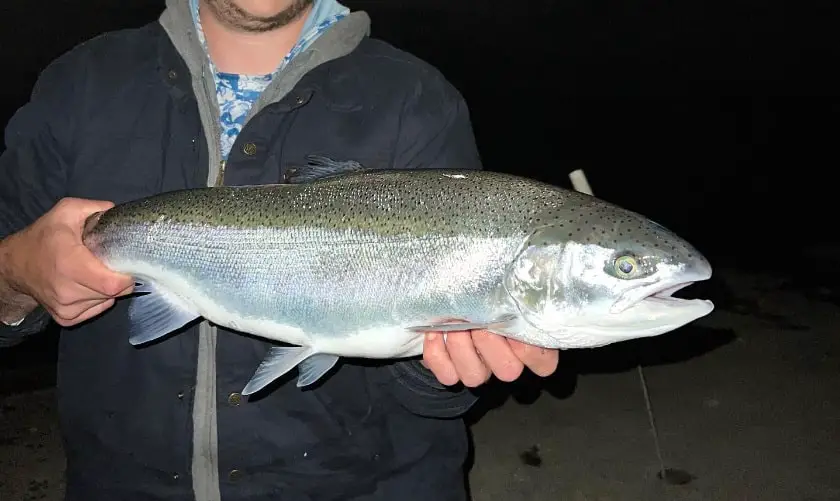
Fly fishing at night can be an exciting and rewarding experience, especially if you use effective methods and take the necessary safety precautions to fly fish in the dark. In this article, I’ll share some valuable guide tips to help you increase your chances of catching fish after dark with a fly rod.
Insights from a Nighttime Fly Fishing Expert
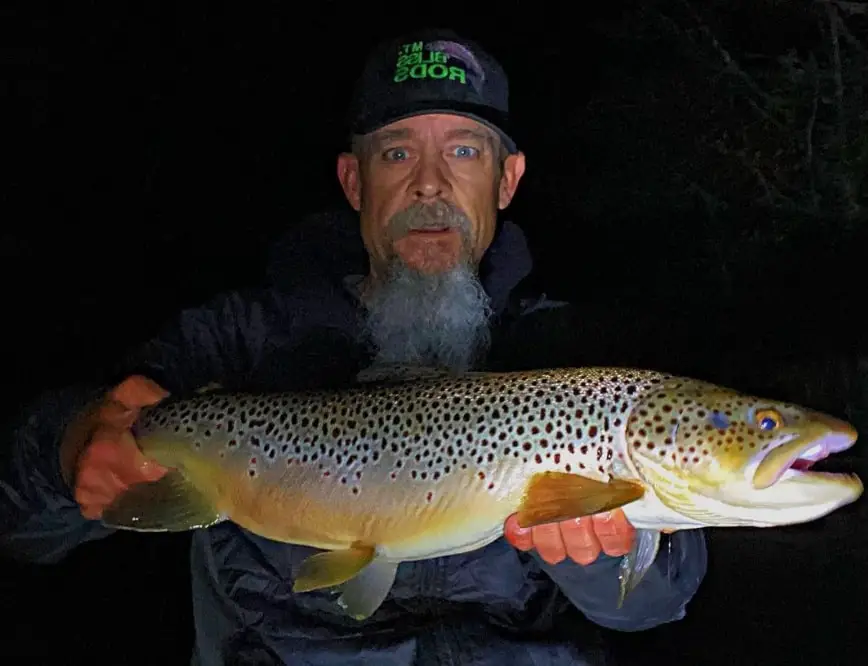
I’ve been night fishing since I was a kid, with 12-hour night fishing trips for salmon, steelhead, trout, and bass on my local streams and lakes. I’m also known for musky guiding for massive musky at night.
But, I wanted to provide you with more than just my tips and advice, so I turned to another expert in the field – guide Wild Bill from Wild Bills Guide Service.
Bill’s knowledge and unique tactics for catching huge brown trout at night have given me invaluable insights that I’m eager to share with you. Bill is an expert at fishing mouse flies in the dark for large predatory brown trout.
And, to make things even better, almost all of the pictures in this article are sourced from Bill’s website and Instagram page, with his permission of course! Be sure to check his website for some of the largest trout I’ve seen.
Fish Do Bite at Night!
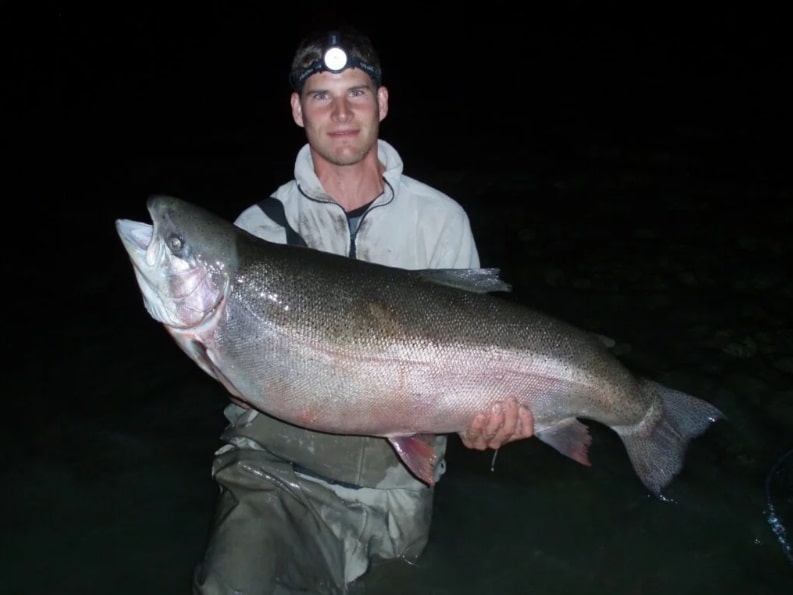
You might wonder if fish are willing to take the bait during the darkness, and the answer is a resounding yes! Most fish, including trout, bass, and saltwater species, tend to be more active and feed more at night, especially in places with heavy angler traffic during the day.
Even the current world-record rainbow trout and some other record-size trout were all caught at night with and without a fly rod. I don’t think the record was caught with a fly rod, but fly fishing for trout at night can be very effective.
However, let’s be honest; night fishing with a fly rod can be quite challenging, even for experienced anglers. But don’t fret, as I’ll share some valuable tips to make your night fly fishing endeavors much easier and far more effective.
Factors Influencing Fish Activity at Night
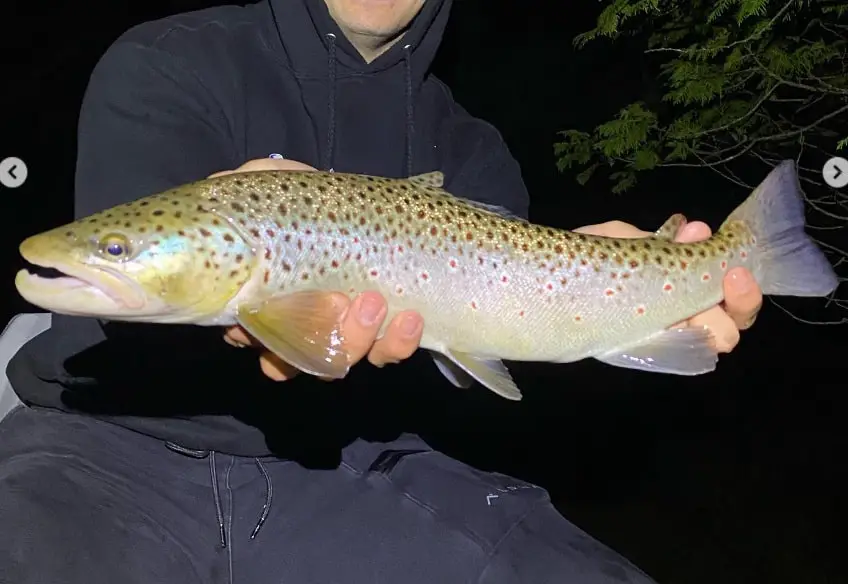
The activity level of fish at night can vary based on several factors. While some rivers and lakes might not offer good night fishing opportunities, many rivers, especially those harboring big trout like brown trout, witness increased fish activity during the night. Understanding the specific conditions is crucial to adjusting your approach accordingly.
The Ideal Time for Fly Fishing At Night
Based on my experience, the best time for fly fishermen to fly fish at night is during the first three hours after sunset, especially during the full moon or the four nights preceding and following it. During this period, most trout and other fish tend to be more aggressive, and the extra moonlight enhances visibility.
Although night fishing for trout and other species without moonlight can also yield results, it poses visibility challenges as it gets pitch dark.
Keep in mind that while trout and other fish may feed throughout the night, their activity tends to diminish around three to four hours after sunset. The reasons for this decline remain somewhat uncertain; it could be due to them being full after feeding for several hours or influenced by other factors.
Reasons Why Some Fish Are More Active at Night
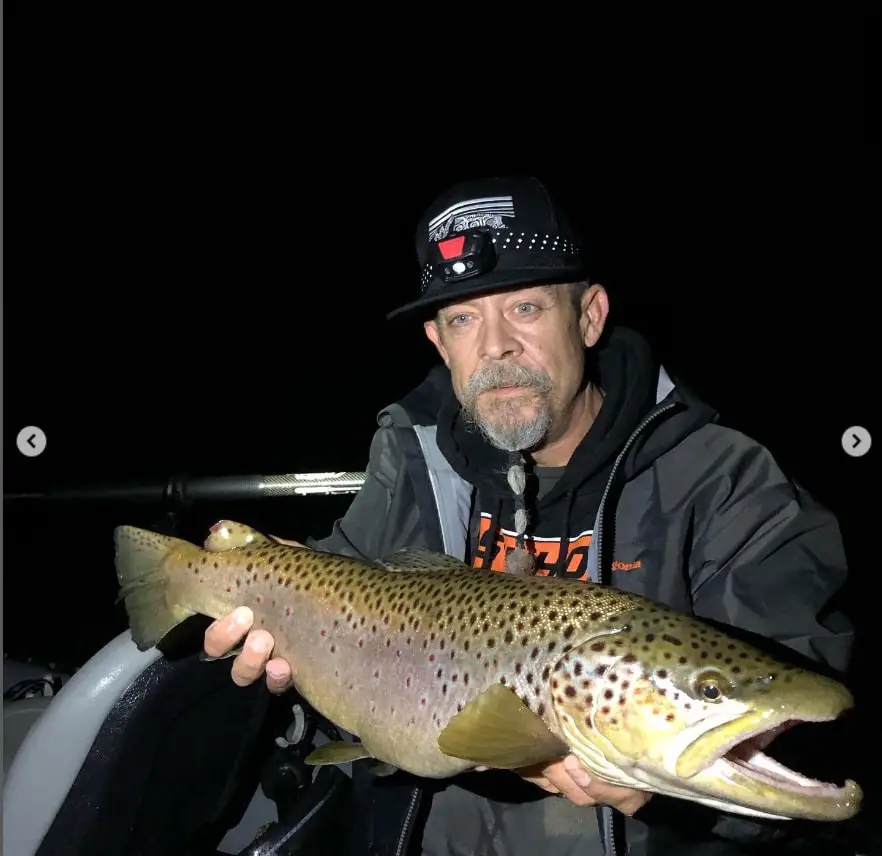
Several factors make brown trout more likely to bite at night:
- Increased Food Availability: Just before darkness falls, insect activity typically increases, attracting predatory fish like trout. Additionally, smaller trout and baitfish also become more active during this time, drawing the attention of larger fish looking for a meal.
- Reduced Daytime Pressure: In heavily fished areas, trout and other fish species might become less active during the day due to angler or boat pressure. Consequently, they become more nocturnal and predominantly feed at night, especially the larger and wiser fish like brown trout.
- Cooler Water Temperature: Hot summer months prompt some fish, particularly trout, to be more active during the last hour before dark, throughout the night, and into the early morning hours. The cooler water temperatures during these times encourage feeding behavior and also entice them out of deep waters into areas anglers can catch them.
Challenges of Night Fly Fishing
Fly fishing at night presents several challenges that you need to be aware of before heading out:
- Limited Visibility: Fishing in the dark can be tricky, and reduced visibility increases the risk of accidents, such as falls, tangling your gear, or losing your way back. Moreover, casting accurately and detecting strikes becomes more challenging.
- Casting and Targeting: Covering the water effectively becomes more difficult without proper visibility, affecting your casting accuracy and your ability to target specific areas where big fish may be lurking.
- Strike Detection: Detecting bites while drifting flies is particularly challenging at night, as it’s harder to see your line and fly. Swinging flies is much easier to detect the bite.
- Tangles: Untangling line and leader and fixing knots become more difficult in the dark, especially for inexperienced anglers. Even line wrapping around the rod tip is more common.
- Hiking In and Out: Navigating in the dark can be tricky, and some anglers may encounter mishaps while hiking in and out of fishing spots. It’s important to have good wading boots with good traction.
- Taking Pictures: Nighttime photography can be challenging, and capturing a great shot of your trophy fish might be harder than during the day. Plan ahead, and research how to take better nighttime pictures. Familiarize yourself with the best nighttime camera settings to ensure you’re ready for those remarkable shots.
Safety Is Priority: Helpful Tips for Safe Night Fishing
To make your night fishing experience more successful and enjoyable, here are some valuable tips:
- Fish Familiar Waters: Stick to fishing spots you know well to minimize the risk of getting lost or encountering unforeseen hazards. Venturing into unfamiliar territory at night can be dangerous.
- Carry a Headlamp and Extra Batteries: Invest in a bright headlamp to improve visibility while walking trails, crossing rivers, and handling fish. Ensure you have spare batteries in case you need them.
- Move Slowly: Take your time both on the trail and in the water to avoid spooking brown trout that may be nearby.
- Inform Someone of Your Plans: Always let someone know where you’re going and when you plan to return. This ensures that someone is aware of your whereabouts and can assist in case of emergencies.
- Use Glow Sticks: Attach a glow stick to your leader or fly line to help you see it better in the dark so you are less likely to hook yourself and are more likely to see a strike too.
- Wear Safety Glasses: All my clients must wear glasses to protect their eyes from stray hooks. At night, a set of clear safety glasses are highly recommended.
- Proper Wading Gear: Good wading boots and chest waders, combined with a snug wading belt, will keep you safe from abrasion, bugs, poisonous plants, and animal bites.
Where to Locate Fish at Night
Fish behavior and habitat may change slightly at night and this means it might be hard to find trout. Here are some tips on where to locate brown trout at night:
- Small Trout: Smaller brown trout tend to stay close to their daytime locations when feeding at night. They avoid venturing into larger fish territory to avoid becoming prey. Look for them in areas where they typically reside during the day.
- Large Trout: Big brown trout exhibit different behavior at night. They often move from their deep resting spots and venture into shallower water in search of food. Keep an eye on areas where smaller fish, minnows, crawfish, and other prey are present.
- Bass: Many bass will move into hollows or be right on top of structures looking for food.
- Transition Zones: Focus on areas where the river transitions from deep to shallow or where there are structures like undercut banks. These areas provide cover for brown trout during the day, and they tend to venture out from these spots at night.
- Know Your Fish: Familiarize yourself with the behavior and patterns of your target species. Fishing with streamers during the day can help you locate large fish, and since big fish tend to stay in the same area, you can return to fish for them at night.
- Know The Hatches: If you know what rivers have epic hatches and you have the right fly design to match these hatches, you will do much better than just showing you and hoping for the best. Look up local hatch charts for your local river or check with your local fly shop for advice.
- Fish Deep Pools: Deep pools have some of the biggest fish and these spots will be good day or night. Most fly anglers know where these spots are. Fishing streamer flies in these spots is a good option.
- Fish The Water Column: Try fishing different levels of the water column if there are no signs of activity on the surface. Dead drift a fly with a split shot at mid-depth, and also near the bottom, are a good ways to determine where the fish are feeding.
Effective Fly Fishing Techniques at Night
Adapting your fly fishing approach to limited visibility is essential for a successful night fishing experience. Here are some techniques that work well:
- Fly Fishing: Fly fishing at night can be challenging, especially for beginners. However, experienced anglers can find success using nymphs, streamers, and topwater patterns like mouse flies. Stick to familiar surroundings and use flies with contrasting colors for better visibility.
- Target Slower, Deeper Water: Focus your efforts on slower, deeper water, where your fly moves at a more leisurely pace, giving fish more time to spot and strike. These areas often provide prime feeding grounds for trout and other species at night.
- Opt for Straight-Moving Streamers: Choose streamers that have a straight, consistent movement in the water. Avoid jerky or twitchy actions that may spook the fish or make it hard to hit. Smooth and steady stripping movements are best for enticing brown trout, rainbows, and other fish to grab a streamer in the dark. Swinging streamers over shallow runs or a deep pool can be good most nights.
- Noisy Streamers: Try streamers with built-in rattles that produce noise or vibration. The vibrations can attract big fish by stimulating their lateral line, helping them locate and strike the fly even in low visibility.
- Retrieve Slowly: Retrieve your lures slowly to give the fish ample time to spot and react to the fly. Slow movements allow the fish to track and strike more effectively.
- Upsize Your Flies: Consider using slightly larger flies than you would during the day. Brown trout rely more on their senses, including vibrations and silhouettes, at night, just like most predatory fish. Upsizing your streamer flies by an inch or two can increase their visibility and make them more enticing to larger fish.
- Splash Your Flies: Slamming your fly down hard on the surface is a great way to get the fish to notice the fly.
Topwater Flies for Nighttime Fishing
Go Bigger: Using topwater flies at night can be thrilling and effective for targeting trout and other species. Larger flies are easier for both anglers and fish to detect in the dark.
Brown trout and other fish may be less cautious at night, and they are more likely to strike at surface presentations. Experiment with topwater flies like poppers, mice imitations, or other surface patterns for thrilling nighttime fishing experiences.
Dead Drift Your Flies: Dead drifting your flies below the surface and on the surface can be a deadly method for catching trout and other fish species.
Drag and Skate Your Flies: Although dead drifting flies can work, dry fly fishing the surface also works. At times dragging your flies from one side of the river to the other, creating a wake can drive fish crazy and trigger the most aggressive bites. This can be done in a similar fashion as wet fly swinging, but I do this with large dry flies made of foam, deer hair, or Elk hair on the surface. Some Atlantic salmon bomber-style flies are great for this.
Best Colors for Flies at Night
Contrary to popular belief, darker fly colors tend to work better for night fishing. While bright colors may be effective during the day, dark-colored flies create stronger silhouettes against the dark water and sky, making them more visible to fish at night.
Solid black flies are highly effective but opt for dark shades like dark green, brown, or purple if they are hard to find.
Night Fly Fishing Tips From The Experts- A Rewarding Adventure
Fly fishing at night can indeed be challenging, especially for beginners. However, it’s also incredibly rewarding, particularly when you manage to hook that big brown trout. Embrace the thrill of targeting these elusive fish, and remember that practice makes perfect.
Setting The Hook In The Dark
One of Wild Bill’s top tips for night fly fishing is using mouse patterns. The idea is not to set the hook immediately after a hit. Instead, let the fish pull on the mouse pattern after the initial strike. This technique mimics the behavior of a mouse being stunned and drowned, enticing the brown trout to strike again and take the fly.
You should do this with any streamer-type pattern, wait a second or two or wait until you feel the pull.
Whether you’re a novice or an experienced fly angler looking to target brown trout at night, remember these key tips:
- Focus on Streamers and Nymphs: These flies are effective choices for night fishing. Use larger patterns that create more movement and are easier for trout to detect. Flies imitating small baitfish, crayfish, mice, or large insects can be particularly successful.
- Utilize Lighted Indicators: Attach a lighted indicator to your leader or fly line to improve visibility and track your fly’s movement in the dark. This can help you detect strikes and monitor the presentation of your fly. This will also improve your dead drift.
- Consider Moonlit Nights: Fly fishing during moonlit nights can provide additional visibility and make fly fishing at night easier. The moon’s glow illuminates the water, making it easier to see your surroundings and make accurate casts.
- Use Scented Flies: Applying scent to your flies can help compensate for reduced visibility and attract brown trout. Scented fly attractants or fly patterns treated with scent can enhance your chances of success.
- Slow and Steady: A slow and steady retrieve allows the trout to home in on the streamer fly and strike more effectively.
- Pause: When using streamer and mouse patterns, try a steady retrieve for 4 to 6 feet with a three or 4-second pause. This pause can really aggravate and trigger a strike response.
- Wait for the Pull: When using sub-surface streamers or mouse patterns, wait until you feel the fish’s pull before setting the hook.
- Glow In The Dark Fly Lines: If you do a lot of fly fishing at night, glow-in-the-dark fly lines are a good option to help you cast and present your flies, and hit your target.
- Use Shorter Leader: Long leaders at night are not required. Shorter leaders help you hit your target easier and create fewer tangles and problems.
- Use A Heavier Fly Rod: While some others will tell you to use a heavier rod, I don’t feel this is necessary unless you are using really big flies that require bigger fly lines. I still use the same rod and reel I fish with during the day without any issues.
- Make Shorter Casts: Shorter casts are much easier to hit your target, and you are less likely to put your fly in the trees behind you.
- Know You’re Surroundings: One of the biggest frustrations most anglers have when casting flies at night is hitting the trees and bushes both in front and behind them. Even overhanging branches can be a problem. Before you cast, know how much room you have behind you and in front of you.
- Add A Stinger Hook: With streamers, a stinger hook can help you hook those short striking fish.
- Fishing From A Boat: A boat moving slowly is a great way to cover water in a lake or river. Fishing streamers from a boat is a good option because the fly spends more time in the strike zone. The boat can also get you to where the biggest trout are and can keep you fishing in higher percentage areas.
- Upsize Your Leader: At night, fish are not leader shy, so upsize your leader.
Remember, night fly fishing demands extra caution, and it’s crucial to be familiar with the water and practice safe wading techniques.
4 Effective Flies For Night Fishing
When it comes to selecting flies for night fly fishing, having a variety of options in your arsenal is essential. Here are three proven fly types, each belonging to a different category, that will increase your chances of landing those elusive trout after the sun sets:
- Giant Insects: Stoneflies, Drakes, and Hex Mayfly Patterns: If you’re fortunate enough to be on the river during a nighttime Giant Stonefly, Drake, or Hex hatch, having imitations of these gigantic mayflies is a must. Many trout rivers in the USA and Canada have these giant flies. Cricket patterns can also be an excellent nighttime fly pattern. If you can hit a nighttime hex hatch, you could be into some great action.
- Mouse Flies: Mouse fly patterns are a favorite among midnight trout and bass anglers during midsummer. Mouse flies are irresistible to bigger fish and bass with hefty appetites. Simply drop a mouse into pockets and seams along the bank or in deep pools, and be ready for explosive topwater takes. The key is to keep the mouse pattern simple, representing the basic characteristics of a mouse – a furry body, and a tail with legs and ears if you’re feeling fancy. High floating mice patterns are a good option. Consider using the Whitlock Mouse Rat pattern, a fly that does the job perfectly.
- Deer Hair and Articulated Streamers: Streamer patterns are abundant, and most of them will work for trout at night, but I have found that fat-headed streamers that push a lot of water are best. The key is to opt for dark colors to create a distinctive silhouette and ensure they have plenty of wiggly action. Fishing big streamers with multi-section articulated bodies and flowy materials that pulsate in the body and tail in the water are most effective. Kelly Galloup is renowned for his articulated streamer patterns that appeal to nighttime browns, with the Zoo Cougar and the Sex Dungeon being an especially good for night fly fishing. Streamer can be fished with a floating fly line or a sink tip line. Swinging streamer is very effective at night.
- Poppers Flies: Topwater Poppers for bass also work well for trout at night. Poppers can imitate anything swimming on the surface and they create a lot of commotion that entices fish from far away. Cast straight and fish slow. Poppers are good over deep holes to bring fish up.
Remember, within each fly category, there are numerous pattern variations to experiment with. Try different materials and body profiles until you discover the perfect pattern that works wonders in your fishing spot.
Don’t forget to include some terrestrial flies like beetles, moths, and cricket imitations to complete your fly box. With these flies in your repertoire, you’ll be well-equipped for successful nighttime fly-fishing adventures!
See These Great Related Articles:
- Brown Trout Fishing At Night
- Rainbow Trout Fishing At Night
- Steelhead Fishing At Night
- Salmon Fishing At Night
Night Fly Fishing – Your Questions Answered
If you have any questions or would like to share your own experiences and advice for more trout while fly fishing at night, feel free to leave a comment below.
Tight lines,
Graham
